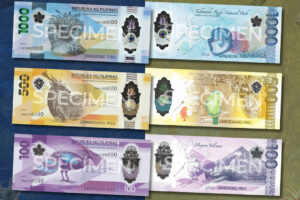The First Philippine Polymer Banknote Series is composed of the 1000-piso polymer banknote, as well as new polymer denominations: 500-, 100-, and 50-piso. — COURTESY OF THE BANGKO SENTRAL NG PILIPINAS
THERE WERE FEWER recorded counterfeit and damaged bills for polymer banknotes versus paper notes, the Bangko Sentral ng Pilipinas (BSP) said on Thursday.
The total documented counterfeits of the P1,000 polymer notes were at one per 82 million pieces from 2022 to November 2024, BSP data showed.
This was equivalent to 10 counterfeits out of 825.4 million in circulation.
“Moreover, these counterfeits were of low quality, as their elements poorly matched the advanced security features of polymer banknotes.”
“In contrast, documented counterfeits of the P1,000 paper banknotes stood at one per 19,000 (98,316 out of 1.86 billion),” it added.
On Monday, the BSP began circulating limited quantities of the “First Philippine Polymer Banknote Series” in the Greater Manila Area.
The polymer series includes new denominations of P50, P100 and P500. The polymer version of the P1,000 bill was already launched in April 2022.
The polymer series features native and protected species in the country. The banknotes are also cleaner, more durable and include more security features to make it harder to counterfeit, the BSP said.
Its new security features include clear windows, embossed mirror denominations and iridescent figures, among others.
“The BSP also receives fewer worn-out polymer banknotes compared with paper banknotes,” it said.
From 2022 to November 2022, there were a total of 689,571 pieces or 0.08% of the P1,000 polymer banknotes were returned as worn-out or damaged.
“In comparison, of the P1,000 paper banknotes issued during the same period, 54.4% (or about one billion pieces) were returned to the BSP as worn-out and damaged banknotes.”
The polymer banknotes help in “significantly reducing replacement costs,” the central bank said.
Polymer notes also have a lifespan of 7.5 years compared with the 1.5 years for paper banknotes, the BSP added.
“The global warming potential (GWP) of the P1,000 polymer banknote is 38.36% lower than that of its paper counterpart, as shown in a study conducted by De La Salle University’s Center for Engineering and Sustainable Development Research in 2023, commissioned by the BSP,” it said.
“The lower GWP is attributed to the longer lifespan of polymer banknotes, which reduces the consumption of resources, such as electricity, throughout their life cycle.”
The central bank earlier said it plans to issue around 70 million to 90 million pieces per denomination of the new polymer bills.
Latest data from the BSP showed that 661 million pieces of the P1,000 polymer are already in circulation, equivalent to around 33% of the overall circulation of P1,000 bills. — Luisa Maria Jacinta C. Jocson

